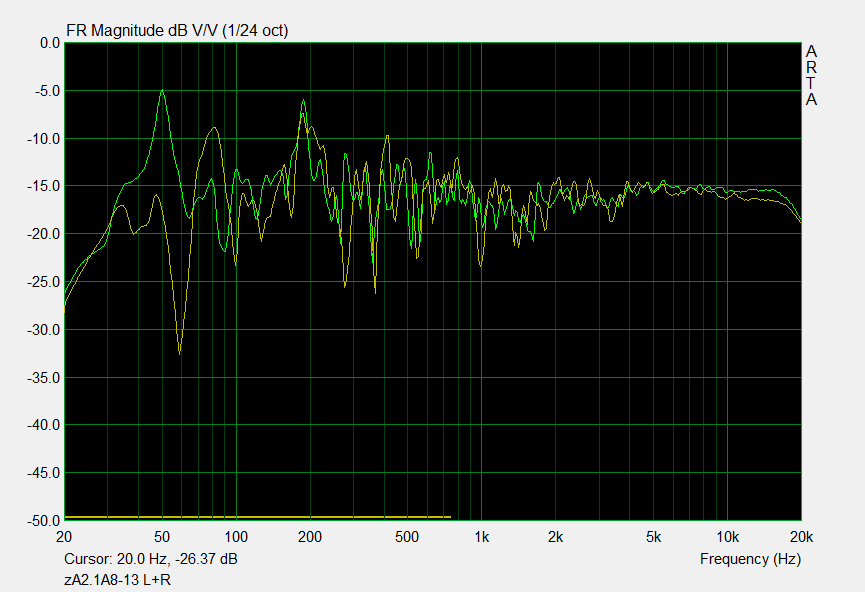
Electrostatic Loudspeaker Attributes, the Mythic and the Mythical
Over the decades, there’s been a mix of wonders and flaws claimed for this interesting and surprisingly ancient type of loudspeaker. In this posting, I address a range of electrostatic attributes. Naturally, in the process, I keep in mind our 2008 version of the first practical design -- the one that started it all in 1955 -- namely the original JansZen Wide Range Tweeter. This was developed by my father, Arthur A. Janszen, a few years before several others began working on their own embodiments.
You’re probably hoping this posting won’t entail a continual hyperbolic slant in our own favor, which I've tried to avoid, despite this being me writing for the JansZen blog.
TLDR: Every company making electrostatics has its own approach, so each design in this category is a mixed bag of attributes -- mostly positive, some negative, and rarely indifferent.
To begin with, and probably why you’re interested in electrostatics, all offer exceptional clarity, immediacy, smoothness, low distortion, and transparency, especially in the midrange and treble. Various criticisms, however, have accumulated over the decades, spread out among a number of makers, past and present.
The upshot of the lengthy comparative notes below is that, although not perfect for every situation or taste in sound, JansZen electrostatic hybrids defy the usual criticisms. They’re as compact, setup-friendly, punchy, bass-rich, and trouble-free as any conventional loudspeaker, yet embody all the mythic sonic attributes that have always drawn people to electrostatics.
They’re also unique in two important ways: they’re the only monopole electrostatics, and also the only ones with controlled dispersion. This minimizes the influence of the listening room, so if you’re fond of attending live performances, you’ll like how a JansZen releases you from your listening room and transports you to each individual recording venue.
If you'd like a refresher first about how electrostatics work and what makes them better, you can start here.
Alrighty, then, on to the mythical and semi-mythical aspects and discussions thereof:
Amplifier requirements
Reliability
- Inadequate protection against the formation of unintended high voltage pathways. This can lead to clicking, popping, hissing, or squeaking sounds. Soot and dust from the air can collect on surfaces due to the presence of static electricity. Our design prevents dust collection as much as possible, and prevents whatever debris is inevitably attracted from coming into contact with any of the high voltage parts. Also, the polarization voltages are relatively low, so the tendency to attract particulates is commensurately low.
- Inadequate or nonexistent protection against arcing. When the stator electrodes are not insulated, or are insufficiently insulated, sparks can puncture the working diaphragm, eventually accumulating to the point of causing driver failure. Our electrodes can withstand extreme voltages without allowing a spark. In fact, our electrodes glow blue with plasma and generate ozone without arcing as part of our tweeter Q/C test regimen, so should be alright with amplifiers that are much more powerful than recommended. But still, we recommend against trying that at home.
- Loss or alteration of membrane tension. To work properly, the diaphragm that vibrates to make the sound must be not too tight or too loose. There are several ways that it can change, such as being over-stretched when the speaker expands thermally from high temperatures during transport, but then not recovering completely, or losing adhesion at its edges, or a phenomenon called "creep," where a polymer gradually relaxes on its own over time.
There is a particular problem with one well known design, where to work properly, all the tension has to be applied in the vertical direction, and none in the horizontal. Over time, however, tension can accumulate in the horizontal direction, usually due to polymer aging and chain creep that gradually adds horizontal tension. The result is that the membrane gradually saddles back toward the rear stator and eventually collapses onto it.
- Failed bias supplies. Electrostatic loudspeakers require a constant electrostatic charge on their diaphragms. Because our electrostatics are not handling low frequencies, they do not need such high charge voltages, so our bias supply can have a minimal number of components -- no power transformer, no oscillator, no active circuitry. This makes it inherently reliable, as well as not being a source of any type of radiated emissions.
- Failed signal step-up transformers. Electrostatic loudspeakers need high voltages to vibrate the membrane. As with the low diaphragm charge voltage situation, our electrostatics do not need very high drive voltages, and this means that the signal transformers endure relatively low stress.
- Loss of membrane coating. Electrostatic loudspeakers require a microscopically thin, semi-conductive coating on the membrane to distribute the bias charge. There have been designs that inherently allow the coating to gradually disappear. Our coating is not only stable, but is protected by an additional membrane that is laid over it, which to our knowledge is unique.
Bass depth
Electrostatics are all dipoles. Not to constantly harp on JansZen electrostatics, but this raises an important point – of all electrostatics, ours are the only ones that are not dipoles. This has three advantages:
- without the back wave, room excitation is reduced, which improves the ratio of recorded sound to room sound. This improves realism and better conserves recorded ambiance by not swamping it with room reverberancy
- omitting the back wave also eliminates comb filtering coloration created when a back wave reflects from the front wall and recombines after a short transit delay with the direct sound
- reduces space requirements by allowing placement close to the front wall
Hybrid Shortcomings
Wimpiness and Delicacy
Setup and Listening Area
Planar magnetic (magnetostatic) vs. electrostatic loudspeakers. It's easy to mistake a planar magnetic for an electrostatic, because they look about the same. Examples of magnetostatic planars are AMTs, isodynamic or quasi-ribbon tweeters, true ribbon tweeters, and full range implementations, such as made by Magnepan or Apogee. Both types vibrate planar membranes to make sound, but the operating principles could not be more different.
The most common planar magnetic, the quasi-ribbon, makes sound by vibrating a relatively thick plastic membrane that's loaded down by a serpentine track of metal foil bonded to it. The foil is needed to conduct the current that generates the dynamic magnetic force that makes it vibrate.
The membrane is thick to support the foil and withstand the heat generated when current flows through the metal track. One of the drawbacks to quasi-ribbons is that the heat causes the diaphragm tension to change with loudness, because the membrane material expands and contracts quickly with temperature, so the tonality isn’t entirely stable with loudness.
A true ribbon has a continuous metal foil and no supporting plastic membrane, so it’s far more stable with loudness than a quasi-ribbon. Its main potential pitfall is metal fatigue where the diaphragm is supported at its edges, which can cause the ribbon to fail at some point.
For both ribbon and quasi-ribbon, the weight of the metal foil presents a mechanical load much greater than the air, and this significantly influences its motion, creating a frequency-dependent delay between when the signal arrives and when the diaphragm moves. The weight also makes it quite hard to arrange things so that the diaphragm stops when it’s supposed to, so the transient response typically shows not only some delay, but also significant ringing.
The prime advantage of planar magnetic drivers is a big one, and it's the planar construction itself. This lets them operate as true pistons, and thus produce essentially uncolored sound. I'm sure that you who are fans of Maggies and Apogees can attest to the smooth, clear sound they make.
As the electrostatic moniker indicates, an electrostatic loudspeaker relies on electrostatic force, rather than magnetism. This type of driver applies a static electrical charge to an extremely much lighter diaphragm than those found in magnetostatic planars, and vibrates it by way of an alternating electrical field pushing and pulling that layer of charge. One advantage is that this makes no heat, so the performance is perfectly stable with loudness.
The big advantage, however, is the extreme lightness of the electrostatic diaphragm, which means its load is almost purely acoustical, i.e., it’s just the air itself. No energy is consumed accelerating its own weight, and thus no delay occurs after the signal arrives asking it to move. This lightness not only makes it able to respond instantly to transients, but also makes it easy to arrange for it to stop moving instantly when it’s supposed to.
Another difference is that the sound from planar magnetics has to penetrate a bulky magnet structure, at least on the back side, and in some cases both sides, whereas an electrostatic is fully open to its surroundings and thus unencumbered by surrounding structures.
--------------------------
Thanks for your attention. I hope I’ve left you with a new appreciation for what electrostatic loudspeakers can and can’t do. I also hope that, if you’re not now nor ever have been an electrostatic loudspeaker owner, you've gained a sense that they’re worth considering.
All the best,
David Janszen
3 Responses
AV
I enjoyed the blog, I hope others did too. I do agree with most of it. The true ribbon speaker has more qualities than mentioned here, though the mechanical fragility is indeed, and in due course, an issue. However, given the ease and low cost with which a membrane can be replaced – especially if the speaker has been built by oneself – mitigates the problem.
To say that “planar magnetics has to penetrate a bulky magnet structure” is a bit inaccurate. First, the sound only propagates through the slits in-between the magnet rows (like in the Magnepan example), but do not “penetrate” the magnetic strips themselves. In fact, they (air molecules) bounce off them and hit back on the membrane (admittedly, with some diminished energy). A true dipole ribbon doesn’t not suffer from this phenomenon. Second, the same is true for an electrostatic membrane, whether sandwiched between perforated plates (ML), wires, cast electrodes (Beveridge), etc. Third, it is not quite accurate to claim that an electrostatic membrane will “stop on a penny”, or instantly, although it will do so much much quicker than a dynamic driver, due to its low mass/accumulated energy. But in physics, once a mass is excited it will not truly stop instantly. Still, save for plasma speakers, that’s the closest we can get to instant stop.
All planar membranes obviously suffer to a degree from displacement non-linearity the closer it gets to its frame (and center spacers/dampers, if any) – at which point it cannot move at all. Some compensation can be had by judiciously increasing the magnetic/electrostatic force progressively nearer the frame – but the phenomenon cannot be entirely resolved. It is more pronounced with full range planar membranes, less of a problem with high frequency ones. The late Harry Pearson famously – or infamously – called it the “credit card” effect/sound.
In my opinion, no matter how much the dynamic drivers improve (and they certainly do) they will never equal the speed and transparency of electrostatic speakers, due to the former’s manyfold greater mass. As we know, it is “difficult” to bend the laws of physics. Dynamic drivers (woofers) can progressively eliminate more and more nasty distortions as technology advances – but cannot emulate the speed. My own compromise on this is to employ dynamic drivers at a tiny fraction of their max. potential displacement, thus making them move as little as, and accumulate as little energy as, possible. The price for that is (greatly) increased radiating acreage and judicious choice of driver size.
Hopefully we can enjoy more blogs here.
AV.
william lawhorn
A very informative and easy to comprehend article. I now have a greater appreciation for your speakers and company. .
Leave a comment
Comments will be approved before showing up.
Also in Issues in Audio

Side-stepping the Side Wall Issue


David
August 05, 2022
David, do electrostatics show a rising response anechoically on axis ?